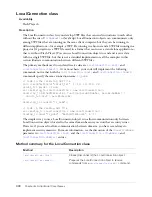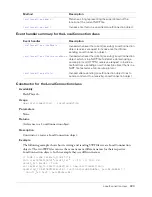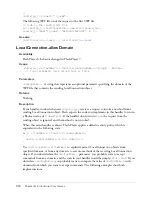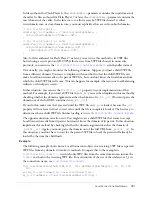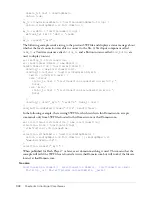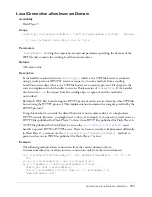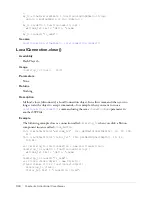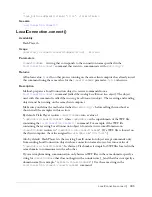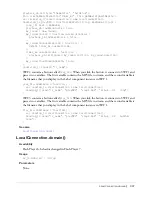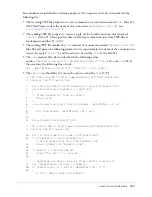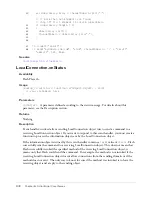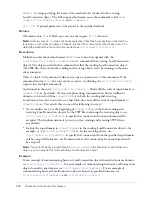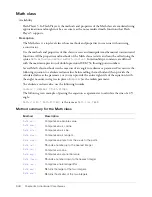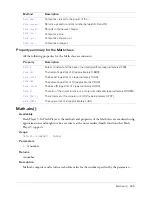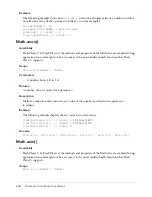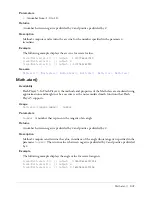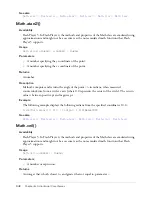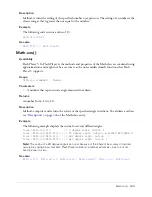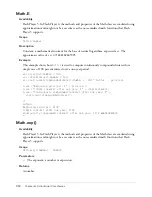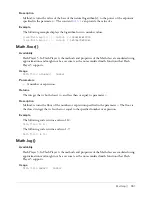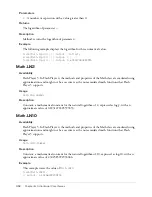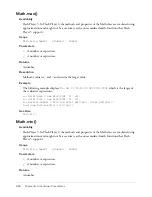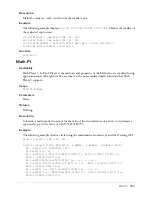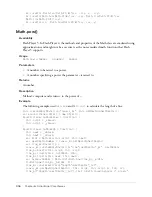
342
Chapter 6: ActionScript Core Classes
method
A string specifying the name of the method to be invoked in the receiving
LocalConnection object. The following method names cause the command to fail:
send
,
connect
,
close
,
domain
,
onStatus
, and
allowDomain
.
p1,...pN
Optional parameters to be passed to the specified method.
Returns
A Boolean value:
true
if Flash can carry out the request;
false
otherwise.
Note:
A return value of
true
does not necessarily mean that Flash successfully connected to a
receiving LocalConnection object; it means only that the command is syntactically correct. To
determine whether the connection succeeded, see
LocalConnection.onStatus
.
Description
Method; invokes the method named
method
on a connection opened with the
LocalConnection.connect(
connectionName
)
command (the receiving LocalConnection
object). The object used with this command is called the sending LocalConnection object.
The SWF files that contain the sending and receiving objects must be running on the same
client computer.
There is a limit to the amount of data you can pass as parameters to this command. If the
command returns
false
but your syntax is correct, try dividing the
LocalConnection.send()
requests into multiple commands.
As discussed in the entry
LocalConnection.connect()
, Flash adds the current superdomain to
connectionName
by default. If you are implementing communication between different
domains, you need to define
connectionName
in both the sending and receiving
LocalConnection objects in such a way that Flash does not add the current superdomain to
connectionName
. You can do this in one of the following two ways:
•
Use an underscore (_) at the beginning of
connectionName
in both the sending and
receiving LocalConnection objects. In the SWF file containing the receiving object, use
LocalConnection.allowDomain
to specify that connections from any domain will be
accepted. This implementation lets you store your sending and receiving SWF files in
any domain.
•
Include the superdomain in
connectionName
in the sending LocalConnection object—for
example,
myDomain.com:myConnectionName
. In the receiving object, use
LocalConnection.allowDomain
to specify that connections from the specified superdomain
will be accepted (in this case, myDomain.com) or that connections from any domain will
be accepted.
Note:
You cannot specify a superdomain in
connectionName
in the receiving LocalConnection
object—you can only do this in the sending LocalConnection object.
Example
For an example of communicating between LocalConnection objects located in the same domain,
see
LocalConnection.connect()
. For an example of communicating between LocalConnection
objects located in any domain, see
LocalConnection.allowDomain
. For an example of
communicating between LocalConnection objects located in specified domains, see
LocalConnection.allowDomain
and
LocalConnection.domain()
.
Summary of Contents for FLEX-FLEX ACTIONSCRIPT LANGUAGE
Page 1: ...Flex ActionScript Language Reference...
Page 8: ......
Page 66: ...66 Chapter 2 Creating Custom Classes with ActionScript 2 0...
Page 76: ......
Page 133: ...break 133 See also for for in do while while switch case continue throw try catch finally...
Page 135: ...case 135 See also break default strict equality switch...
Page 146: ...146 Chapter 5 ActionScript Core Language Elements See also break continue while...
Page 808: ...808 Chapter 7 ActionScript for Flash...
Page 810: ...810 Appendix A Deprecated Flash 4 operators...
Page 815: ...Other keys 815 Num Lock 144 186 187 _ 189 191 192 219 220 221 222 Key Key code...
Page 816: ...816 Appendix B Keyboard Keys and Key Code Values...
Page 822: ...822 Index...

